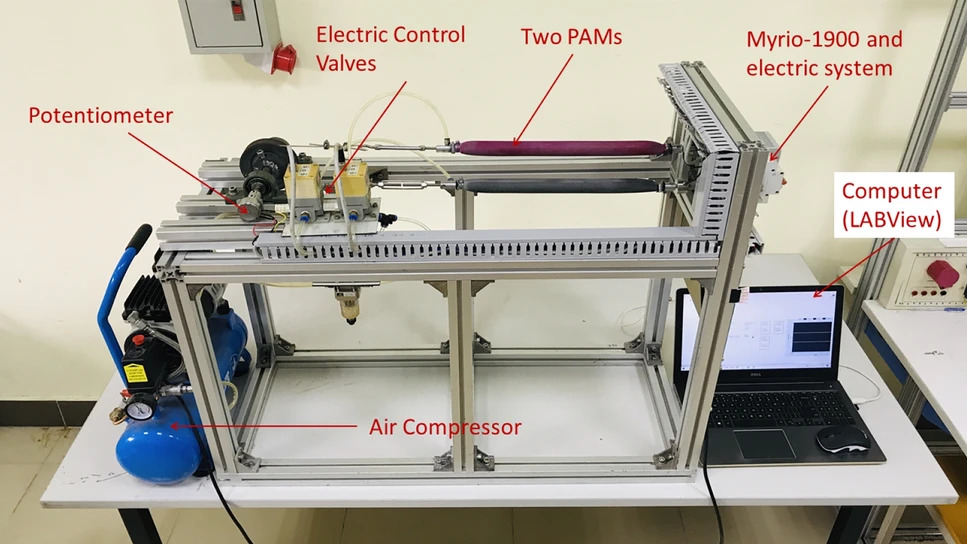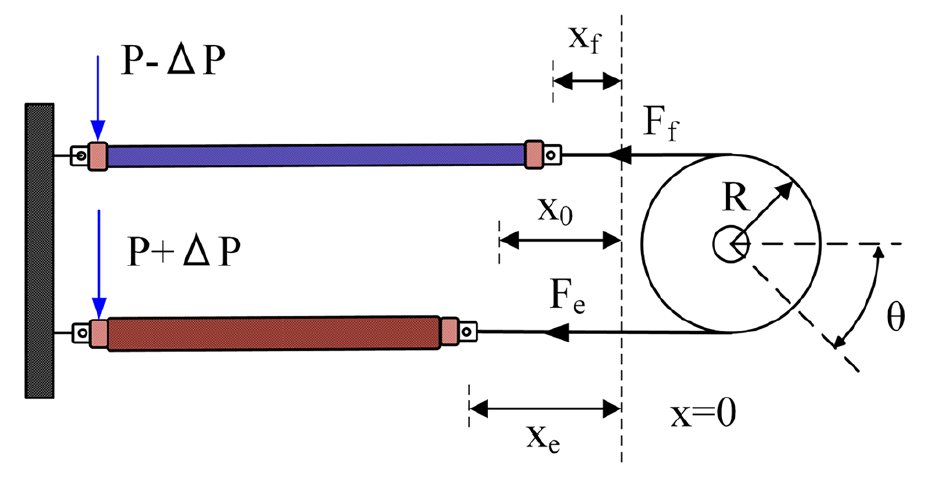Advancing Trajectory Tracking Control of Pneumatic Artificial Muscle-Based Systems
- Research
Researchers from Japan and Vietnam develop a new approach that utilizes fuzzy logic to estimate unknown parameters and control nonlinear pneumatic artificial muscles
Pneumatic artificial muscles (PAMs) are artificial devices that can simulate the mechanics of human muscles, and have shown great promise in industries requiring human-robot interaction systems. Despite their potential, controlling the trajectory performance of PAM-based systems is challenging owing to their nonlinear characteristics. Now, researchers from Japan develop a novel adaptive sliding mode controller that uses fuzzy logic to estimate PAM-based system’s parameters, promising enhanced tracking accuracy and adaptability compared to traditional control methods.

Image Title: Test bench for pneumatic artificial muscle (PAM)-based actuator
Image Caption: PAM technology has widespread applicability in various industries. But precise tracking of the PAM-based’s systems parameters is crucial and yet challenging for traditional control methods. The adaptive fuzzy sliding mode control (AFSMC) for PAM-based systems proposed by researchers from Japan exhibits enhanced controller performance and remarkable adaptability to sudden external disturbances, swiftly returning to the original trajectory through manipulation of its control output.
Image Credit: Ngoc-Tam BUI from SIT, Japan
Image Link: https://www.nature.com/articles/s41598-023-34491-3
License Type: CC BY 4.0

Image Title: Schematic of two opposing pneumatic artificial muscles (PAMs)
Image Caption: PAMs use pressurized air to mimic the mechanics of human muscles, stiffening and contracting when supplied with pressurized air and softening and lengthening upon releasing the air. In this study, researchers from Japan propose a novel control strategy that allows accurate tracking of PAM-based systems, promising their advanced applications in rehabilitation technology.
Image Credit: Ngoc-Tam BUI from SIT, Japan
Image Link: https://www.nature.com/articles/s41598-023-34491-3
License Type: CC BY 4.0
In recent years, pneumatic artificial muscles (PAMs) have emerged as promising actuators for simulating human-like movements, with prominent applications in various industries including robotics, rehabilitation, and prosthetics. PAMs are usually composed of rubber and covered with braided yarn and can mimic the mechanics of human muscles. They can stiffen and contract on being supplied with pressurized air and soften and lengthen upon releasing the air. However, PAM is a nonlinear system and experiences huge latency, making it important to have control systems that can regulate their performance.
While determining a nonlinear mathematical model for PAM is challenging, researchers in the past have proposed many control methods to solve the problems associated with PAM. However, while these traditional control methods exhibit decent performance, they are not able to deal with PAM’s nonlinearity and hysteresis. Moreover, while learning control algorithms have been theoretically effective in improving PAM-based system’s performance, their implementation is practice is quite difficult.
To overcome these limitations and address this open problem, a group of researchers led by Associate Professor Ngoc-Tam BUI of the Innovative Global Program, College of Engineering, Shibaura Institute of Technology in Japan, along with Dr. Quy-Thinh Dao of Hanoi University of Science and Technology, has proposed a novel solution. In their study published in the journal Scientific Reports on 22 May 2023, they propose a control approach called “adaptive fuzzy sliding mode controller (or AFSMC)” that uses fuzzy logic (a type of computational thinking) for estimating control parameters of PAM-based systems.
“The proposed innovative control strategy leverages the Takagi–Sugeno fuzzy algorithm to estimate the disturbance component and automatically update the output variable values, demonstrating enhanced tracking accuracy and adaptability compared to traditional sliding mode control methods,” explains Associate Professor BUI.
The researchers first developed a sliding mode controller with a control signal that incorporates a special variable to estimate the disturbances and improve the control performance. Next, they designed an adaptive fuzzy algorithm, wherein parameter vectors of the component rules are automatically updated by an adaptive law, to compute the disturbance variable. The stability of the developed ASFMC algorithm was then analyzed using the Lyapunov stability condition (used to study the stability of a nonlinear system). Furthermore, the researchers conducted a series of experiments to assess the performance of their controller by comparing it with traditional sliding mode control methods.
Remarkably, the AFSMC approach exhibited improved tracking accuracy, with a root mean square error value of 2.68° at a frequency of 0.5 Hz under load, while the sliding mode controller approach displayed a higher value of 4.21°. Moreover, it showed exceptional adaptability to abrupt external disturbances. Explaining these results further, Associate Professor BUI says, “In a comparative evaluation against the well-known commercial rehabilitation system, LOKOMAT, the AFSMC controller delivered similar performance. It also exhibited superior adaptability to sudden load changes, swiftly returning to the desired trajectory by manipulating its control output.”
These findings thus point to the potential of the novel AFSMC approach for integration into robotic rehabilitation devices, assistive devices, and physical therapy equipment for precise and personalized therapy. Moreover, this approach can aid in the design and development of advanced prosthetic limbs for enhanced functionality and rehabilitation outcomes.
Talking about the long-term implications of this study, Associate Professor BUI says: “With the outcomes of this research, the emergence of a commercial rehabilitation system actuated by PAM can be anticipated within the next 5 to 10 years. This innovative system will provide significant benefits to patients, including those with spinal cord injuries and stroke and others requiring rehabilitation.”
While this research has laid the groundwork for advancing trajectory tracking control in PAM systems, we hope that it ignites further exploration and development in the field of rehabilitation technology.
Reference
| Title of original paper: | Adaptive fuzzy sliding mode control of an actuator powered by two opposing pneumatic artificial muscles |
| Journal | |
| Article link: | 10.1038/s41598-023-34491-3 |
Funding Information
This study was funded by the Hanoi University of Science and Technology (HUST) under project number T2022-PC-002.